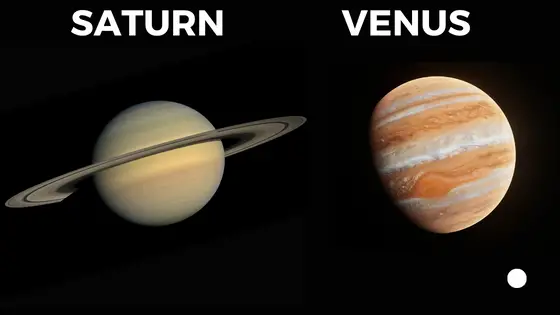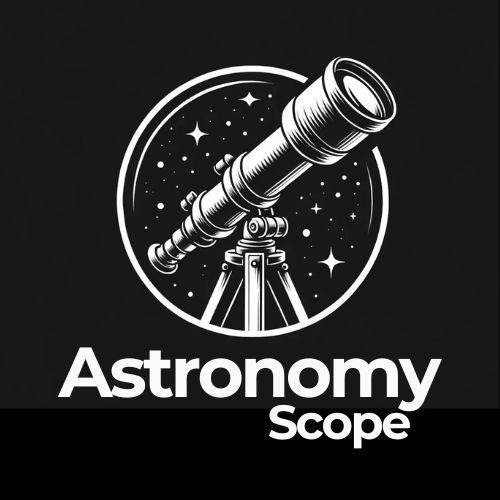Within our solar system, Earth is not alone. It also exists here amongst the Sun, the moon, 8 planets, and 1 dwarf planet. Two of those planets are Saturn and Venus. Saturn is the sixth planet from the Sun, located in between Jupiter and Uranus. Venus, on the other hand, is the second planet from the Sun and is located between Mercury and yours truly, Earth. But how else do Saturn and Venus differ? What do they have in common, even, other than the fact that they’re in the same solar system? Today, we’re going to explore these differences and similarities between the sixth and second planets of our glorious solar system.
So, what are the main differences between Saturn vs. Venus? The main difference between Saturn and Venus is that Saturn is a gas planet/giant, whereas Venus is a terrestrial planet. Other differences include size, temperatures, orbit duration, compositions, and aesthetics.

Interestingly, Saturn is much bigger than Venus, but Venus is much hotter, at least when it comes to surface temperature.
Venus also completes its orbit of the Sun much, much quicker than Saturn does due to it being much closer to the Sun than its counterpart.
So those are the main differences, but let’s explore them further, shall we?
We will also look at some of the main similarities between the two, too. So keep reading for those!
What Are The Differences Between Saturn And Venus?
Saturn and Venus are starkly different from one another when it comes to size, orbit, chemical composition, temperature, number of moons, number of rings, axle tilt, and their aesthetic.
So, it turns out there’s quite a lot that splits these two planets from each other.
One by one, let’s talk about the key differences between Saturn and Venus.
Size and Mass
There’s no fine margin when determining which is the bigger planet. In fact, there’s never a fine margin when comparing any of our solar system’s planets to one another because there are such distinguishable differences.
When it comes to the two planets in question, Saturn is the bigger planet by far.
Saturn has a diameter of 116,460km compared to Venus’ diameter of a mere 12,104km. A stark difference, right?
Saturn has a surface area of 42.7 billion square kilometers, whereas Venus has a surface area of 460.2 million square kilometers.
The same is the case when it comes to mass as well. Saturn has a whopping mass of 569,000,000,000 trillion metric tons compared to Venus’ mere 4870 million million million tonnes.
These figures place Saturn as the second biggest planet in our solar system while Venus sits at sixth, meaning it is only bigger than Mars and little old Mercury.
Orbit Of The Sun
As was mentioned in the introduction, Saturn is the sixth planet from the Sun, whereas Venus is the second planet from the Sun.
Distance from the Sun plays a significant factor when it comes to orbit.
As Venus is much closer to the Sun, it takes much less time for it to orbit it. Venus takes 225 days to orbit the Sun.
Saturn is much further away from the Sun. So, consequently, it takes the planet a humongous 29.4 years to orbit the Sun. Yes, that’s just one orbit of the Sun.
So there is a clear difference in the amount of time these two planets take to orbit the Sun.
Venus is the 2nd farthest planet from the Sun, whilst Saturn is the 6th farthest, meaning Venus orbits the Sun in 225 days, and Saturn does so in 29.4 years.
Chemical Composition
There are many different types of planets. Two of the most common planet types are gas planets and terrestrial planets.
This is where Saturn and Venus differ again.
Saturn is a gas giant, but Venus is a terrestrial planet. What do these different titles mean?
Well, a gas planet/giant is exactly what it says on the tin! It’s a planet composed of gasses, primarily hydrogen and helium.
Venus is a terrestrial planet which is a type of planet that is also known as a telluric planet or more descriptively a rocky planet.
Why is that the most descriptive name for this type of planet?
Well, because a rocky planet is a rocky planet. It’s a planet composed primarily of silicate rocks or metals. Venus is joined in the terrestrial planet category by Mercury, Earth and Mars!
Temperature
This is where things get interesting. Because, in one case, Venus is hotter than Saturn. But in another case, the opposite is true. Confusing, right?
Well, be confused no more. Venus is hotter than Saturn when it comes to surface temperature. Venus’s surface temperature is approximately 475 degrees celsius, whereas Saturn’s surface temperature is approximately -138 degrees celsius.
Why is this the case? The most obvious explanation would be the factor of distance from the Sun.
Venus is relatively close to the Sun, so its surface is kept warm by the rays of sunshine emitted from the giant ball of gas and fire. Whereas Saturn is much further away from the Sun, located in a part of the solar system where it’s much colder.
But when it comes to core temperature, it’s a whole different ball game. This is down to the fact that Saturn is a gas giant, so it produces more of its own heat from its core than Venus.
Saturn has a core temperature of approximately 11,700 degrees Celsius, whereas Venus has a core temperature of approximately 5,200 degrees Celsius.
Number Of Moons
Quite simple, this one. Saturn has a lot of moons, 82, to be specific. Venus? It has no moons. Yes. Zero!
Rings
And again, another simple one. Saturn has 7 rings, which mainly consist of asteroids, comets, and even shattered moons. Venus? Once again, nothing to show here. Zero rings!
Axel Tilt and Rotation
If you didn’t know already, not all planets tilt on the same axle. This is the case when comparing Saturn and Venus.
Venus has an axial tilt of 3 degrees, whilst Saturn’s is about 27 degrees.
Not only is this another clear difference between the two planets, but it also creates another difference, and that is how long it takes for these planets to rotate around its axis.
Venus takes 243 days to complete one rotation of its axis, whereas Saturn takes just 10 hours and 34 minutes to complete one rotation of its own.
Aesthetic
Many of the different factors discussed above cause these planets to look very different.
Saturn appears with a pale yellow color. Venus, on the other hand, appears with a yellowy white.
Venus is the brighter of the two planets, but then again, it is actually the brightest planet in our solar system.
What Are The Similarities Between Saturn And Venus?
Saturn and Venus share orbit patterns, shapes, the fact that they have hotter cores than surfaces, vortexes at their south poles, and cannot support human life.
Despite all those major differences between Saturn and Venus, they do share some similarities. Let’s talk through them now.
Orbit Pattern
As we learned in the previous chapter, it takes Saturn much more time to orbit the Sun than it does Venus.
However, the pattern that these planets’ orbit the Sun remains the same.
Both Venus and Saturn have circular orbits of the Sun.
Both Have a Hotter Central Core
Saturn has a hotter core than Venus’. Alternatively, Venus has a hotter surface area than Saturn.
But what both these planets share when it comes to temperature is the fact there their cores are much warmer than their surface areas.
Both Are Spherical In Shape
Although there are vast differences between the two when it comes to size and mass, both Saturn and Venus are spherical in shape.
Both Have a Vortex at Their South Poles
Since the 70s, NASA has been aware of a strange vortex located at Venus’ south pole. It’s a vortex that is caused when low-pressure forms and sits at the rotation pole of a planet. Air then spirals down from high up in the atmosphere.
Well, in recent years, it has been discovered that Saturn also has a vortex like the one of Venus at its own south pole.
Gravitational Pull
Both planets have a gravitational pull force that interacts with the rest of the universe.
For Saturn, its gravitational pull ensures that its 82 moons and 7 rings continue to orbit it within close proximity.
Can’t Support Human Life
Do plan a space-cation to either of these planets anytime soon, as both are uninhabitable for human life.
There are various reasons why humans can’t visit these two planets, other than the fact that we can’t yet travel to them.
For a start, we wouldn’t be able to survive their hostile temperatures on our own.
There also isn’t any or enough oxygen on either planet to keep us alive and breathing.
Learn more: Is Saturn Habitable? [The Answer May Surprise You]
Finally
Saturn and Venus have more differences than they do similarities.
But the all-important similarity is that they’re both amazing!!
Related Questions
Which is bigger Venus or Saturn?
Saturn is much bigger than Venus. Saturn’s diameter and surface area is over 9x larger. These figures place Saturn as the second biggest planet in our solar system while Venus sits at sixth.
Other planetary comparisons you may want to see:
- Saturn vs Earth [How Do The Planets Differ?]
- Saturn vs Uranus [How Do The Planets Differ?]
- Saturn vs Mars [How Do The Planets Differ?]
- Saturn vs Neptune [How Do The Planets Differ]
- Saturn vs Jupiter [How Do The Planets Differ?]

Hey, my name is Jeremy. I’m a passionate and seasoned astronomer who loves nothing more than observing the night sky. I also love researching, learning, and writing all things Space and the Universe. I created Astronomy Scope to share my knowledge, experience, suggestions, and recommendations of what I have learned along the way while helping anyone to get into and maximize their enjoyment of the hobby.

